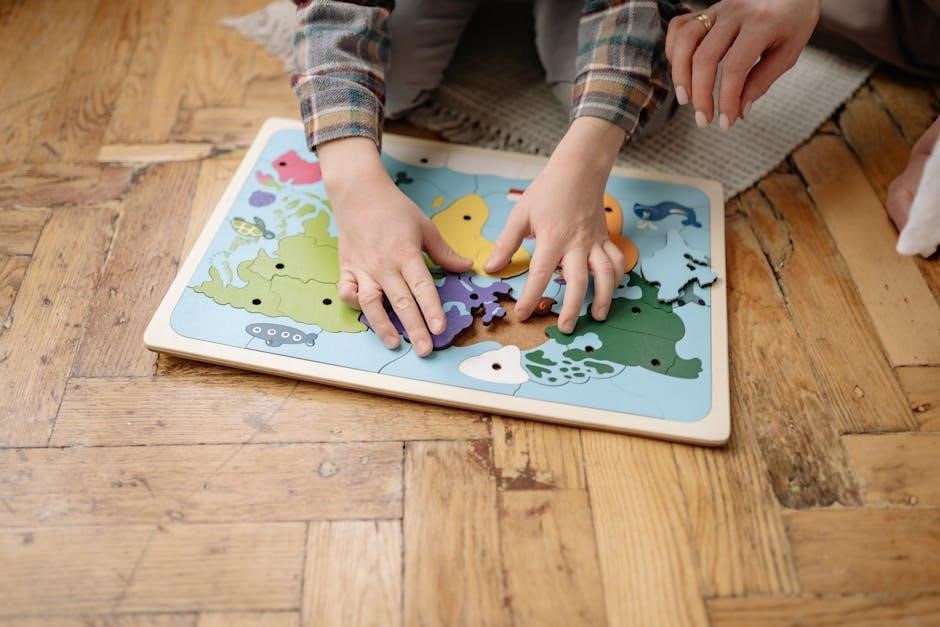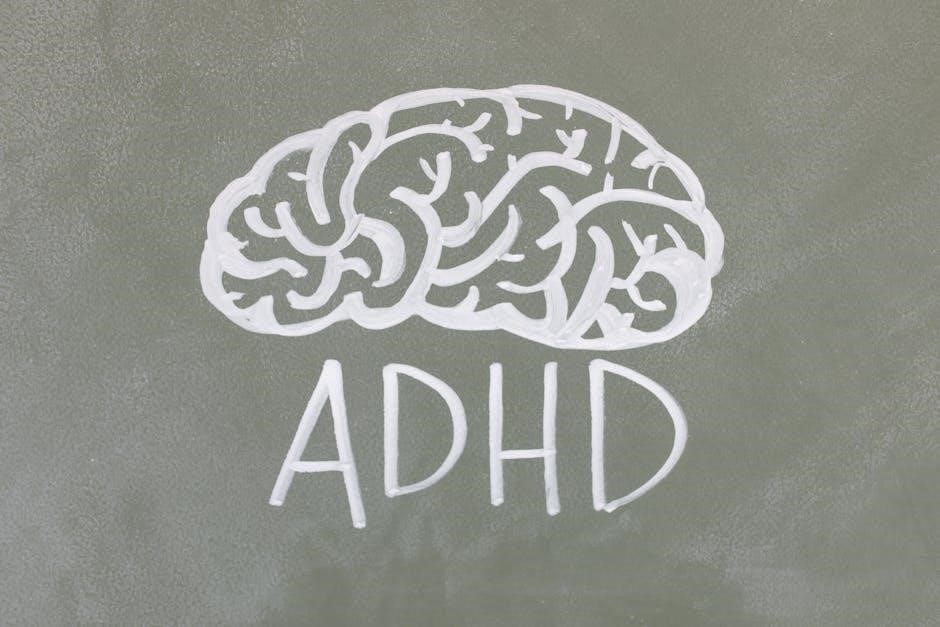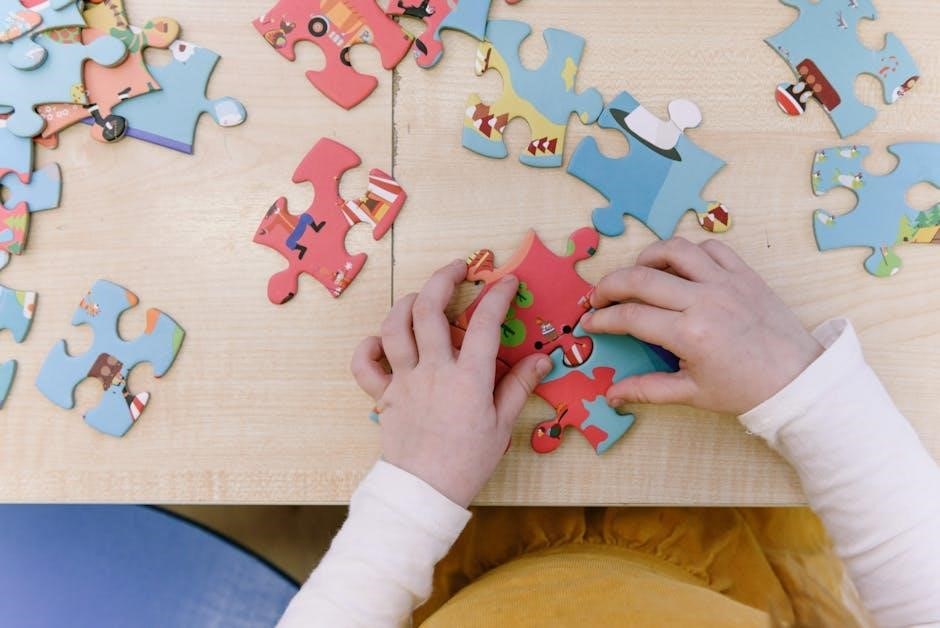
The Whole-Brain Child by Daniel J. Siegel and Tina Payne Bryson offers 12 proven strategies to nurture a child’s developing mind, blending neuroscience with practical parenting advice. NY Times bestseller, it helps parents navigate emotional challenges, fostering resilience and emotional intelligence in children. The authors, both experts in child development, provide actionable tools to create a supportive environment for healthy brain growth and stronger parent-child relationships.
1.1 Overview of the Book
The Whole-Brain Child is a groundbreaking guide by Daniel J. Siegel and Tina Payne Bryson, offering 12 innovative strategies to help parents nurture their child’s developing mind. This New York Times bestseller combines neuroscience with practical parenting techniques to address emotional challenges, tantrums, and developmental stages. The book emphasizes understanding the brain’s structure and function, providing tools to foster emotional intelligence, resilience, and stronger parent-child relationships. By integrating scientific insights with real-world applications, Siegel and Bryson empower parents to create a supportive environment for healthy brain development and lifelong emotional well-being. This essential resource is designed for any parent seeking to raise capable, confident, and compassionate children.
1.2 Authors: Daniel J. Siegel and Tina Payne Bryson
Daniel J. Siegel, a clinical professor of psychiatry at UCLA, and Tina Payne Bryson, a psychotherapist and parenting expert, co-authored The Whole-Brain Child. Siegel, a renowned neuropsychiatrist, specializes in interpersonal neurobiology, while Bryson brings extensive experience in child development and therapy. Together, they blend scientific research with practical parenting solutions, offering strategies to nurture children’s emotional and intellectual growth. Their collaborative work emphasizes understanding the brain’s role in behavior, equipping parents with tools to foster resilience, emotional intelligence, and strong relationships. Their books, including No-Drama Discipline, have become essential resources for modern parenting, bridging the gap between neuroscience and real-world applications.
1.3 Key Concepts and Objectives
The Whole-Brain Child focuses on nurturing a child’s emotional and intellectual development through 12 transformative strategies. The book emphasizes understanding the brain’s role in behavior, helping parents guide children through emotional challenges. Key concepts include fostering emotional intelligence, resilience, and strong parent-child relationships. The authors introduce the “Yes Brain” mindset, encouraging openness and adaptability. Objectives include teaching parents to connect with their child’s emotions, reduce conflicts, and promote healthy brain development. By integrating neuroscience with practical advice, the book equips parents to turn everyday struggles into opportunities for growth, helping children thrive in all aspects of life. Its goal is to empower parents to raise balanced, capable, and emotionally intelligent children.

Understanding the Developing Brain
The Whole-Brain Child explores how the brain develops, emphasizing emotional regulation and the role of parents in shaping a child’s neural growth and resilience through informed strategies.
2.1 Brain Development Basics
Brain development is a complex, dynamic process shaped by genetics, environment, and experiences. In early years, neural connections form rapidly, laying the foundation for future cognitive and emotional abilities. The brain’s structure, including the prefrontal cortex, amygdala, and hippocampus, plays a crucial role in regulating emotions, decision-making, and memory. Understanding these basics helps parents recognize how their interactions influence a child’s neural growth. Siegel and Bryson emphasize the importance of integrating different brain regions to promote emotional regulation and resilience. By fostering a nurturing environment, parents can support healthy brain development, equipping children with skills to navigate life’s challenges effectively. This foundational knowledge is key to applying the book’s strategies successfully.
2.2 The Role of Parents in Brain Development

Parents play a pivotal role in shaping their child’s brain development through consistent, nurturing interactions. By understanding how the brain grows, parents can actively influence neural connections, fostering emotional regulation and resilience. Siegel and Bryson emphasize that parents’ responses to emotional outbursts help integrate a child’s brain hemispheres, promoting better decision-making and self-control. Simple strategies like validation and empathy can strengthen these connections, while harsh reactions may hinder development. Parents’ guidance in teaching emotional intelligence and problem-solving skills is crucial, as these abilities are foundational for lifelong success. The book highlights that parents’ mindful engagement can create a supportive environment where children thrive emotionally and cognitively.
2.3 The Importance of Emotional Intelligence

Emotional intelligence (EI) is critical for children’s social and emotional well-being, enabling them to recognize, understand, and manage their feelings effectively; In The Whole-Brain Child, Siegel and Bryson stress that EI fosters resilience, helping children navigate life’s challenges. High EI correlates with better relationships, academic performance, and mental health. Parents can cultivate EI by labeling emotions, teaching empathy, and modeling healthy emotional responses. These practices strengthen neural pathways, empowering children to regulate their emotions and develop self-awareness. By prioritizing EI, parents equip their children with lifelong skills for emotional balance, stronger relationships, and overall well-being, laying a foundation for a happier, more fulfilling life. This approach is central to the book’s strategies for nurturing a child’s developing mind.

The 12 Revolutionary Strategies
The Whole-Brain Child introduces 12 innovative strategies to guide children’s emotional and intellectual growth, fostering resilience and emotional intelligence through practical, science-backed techniques.
3.1 Strategy 1: Connect and Calm
Strategy 1, “Connect and Calm,” focuses on helping parents create a safe emotional environment for their children. By actively engaging with their child’s feelings, parents can calm emotional storms and foster resilience. This approach emphasizes empathy, validation, and physical connection, such as eye contact or a gentle touch, to help children regulate their emotions. The goal is to shift the child’s state from upset to calm, allowing their rational brain to reconnect. This strategy not only addresses immediate meltdowns but also builds a foundation of trust and emotional intelligence, helping children develop self-regulation skills for the future. It’s a powerful tool for strengthening parent-child relationships while promoting healthy brain development.
3.2 Strategy 2: Name It to Tame It

Strategy 2, “Name It to Tame It,” encourages parents to label their child’s emotions, helping them process and manage feelings effectively. By acknowledging and identifying emotions, children learn to recognize and understand their internal states, reducing emotional overwhelm. This strategy teaches parents to avoid dismissing or minimizing feelings, instead offering empathy and validation. For example, saying, “You seem really upset right now,” helps the child feel understood and calms their emotional response. Naming emotions also enhances emotional intelligence and helps children develop the language to express their feelings. This approach fosters self-awareness, reduces tantrums, and strengthens the parent-child connection, promoting healthier emotional regulation and communication.
3.3 Strategy 3: Engage, Don’t Enrage
Strategy 3, “Engage, Don’t Enrage,” focuses on connecting with your child to prevent emotional escalation. Instead of triggering resistance, parents can use playful or non-threatening language to redirect behavior. This approach avoids power struggles and invites cooperation, helping children feel heard and understood. By engaging their child’s mind, parents can address the root of the issue without escalating emotions.
For example, using humor or a playful tone can shift a child’s focus from frustration to problem-solving. This strategy encourages children to think critically while maintaining emotional balance. It fosters a sense of collaboration, teaching children to manage conflicts respectfully and strengthening the parent-child relationship.
3.4 Strategy 4: Use It, Don’t Lose It
Strategy 4, “Use It, Don’t Lose It,” encourages children to express their emotions through language, helping them process and manage feelings effectively. By teaching kids to “use their words,” parents guide them in developing emotional intelligence. This strategy emphasizes labeling emotions, creating a narrative, and encouraging communication. When children articulate their feelings, it strengthens their ability to regulate emotions and reduces meltdowns. Parents can model this by sharing their own emotions and creating a safe space for expression. This approach fosters emotional awareness, helping children integrate their thoughts and feelings, which is crucial for healthy brain development and long-term emotional resilience.
3.5 Strategy 5: Teach, Don’t Tell
Strategy 5, “Teach, Don’t Tell,” focuses on engaging children by asking open-ended questions that encourage critical thinking. Instead of giving direct instructions, parents guide kids to reflect on their actions and decisions. This approach fosters problem-solving skills and helps children develop self-awareness. For example, asking “What do you think will happen if you do that?” prompts them to consider consequences. This method not only enhances cognitive development but also empowers children to take ownership of their learning. By teaching through questions, parents help kids build resilience and emotional intelligence, preparing them to navigate life’s challenges with confidence and clarity.
3.6 Strategy 6: Say Yes to the Yes Brain

Strategy 6, “Say Yes to the Yes Brain,” encourages parents to foster a positive, open state of mind in their children. By reframing interactions to focus on what children can do, rather than what they can’t, parents reduce resistance and increase cooperation. For example, instead of saying “Don’t touch that,” a parent might say, “Let’s find something safe to play with.” This approach helps children feel heard and understood, promoting a collaborative environment. It also teaches kids to think critically and make good choices, while strengthening the parent-child relationship. This strategy helps children develop self-regulation skills and builds their confidence in navigating the world responsibly.
3.7 Strategy 7: No-Drama Discipline
No-Drama Discipline focuses on reducing conflict and fostering learning through calm, thoughtful responses. Parents learn to remain composed, avoiding punitive reactions that escalate situations. By setting clear boundaries without resorting to threats or punishment, children are guided to reflect on their actions and understand consequences. This approach encourages problem-solving and accountability, helping kids develop self-regulation skills. It also teaches them to think critically about their choices. The goal is to create opportunities for growth and responsibility, rather than simply punishing misbehavior. This strategy helps parents address challenging behaviors while maintaining a positive, supportive relationship with their child, promoting emotional intelligence and resilience. It emphasizes teaching over punishment, leading to lasting behavioral change.
3.8 Strategy 8: Think About Thinking
Think About Thinking encourages children to reflect on their own thought processes, fostering metacognition and self-awareness. This strategy helps kids understand how their brains work, enabling them to make better decisions and solve problems more effectively. By teaching children to observe their thoughts without judgment, parents help them gain control over their mental processes. This approach promotes critical thinking, creativity, and emotional regulation. It also strengthens a child’s ability to learn from mistakes and develop a growth mindset. By integrating both logical and creative thinking, this strategy supports the development of a balanced and resilient mind. It empowers children to navigate challenges with greater clarity and confidence. This tool is essential for nurturing a deeper understanding of oneself and others.
3.9 Strategy 9: Get the Story Straight
Get the Story Straight helps children make sense of their experiences by creating a coherent narrative. This strategy encourages kids to organize their thoughts and emotions into a clear story, reducing confusion and promoting understanding. By guiding children to reflect on their actions and feelings, parents help them process experiences more effectively. This approach fosters self-awareness, accountability, and better decision-making. It also strengthens communication skills and emotional intelligence. By helping children create a “story” of their experiences, parents empower them to learn from mistakes and develop a stronger sense of self. This tool is invaluable for helping kids navigate complex emotions and behaviors, leading to greater clarity and emotional resilience. It supports healthy brain development and lifelong learning.
3.10 Strategy 10: Help Them Develop Mindsight
Help Them Develop Mindsight focuses on cultivating a child’s ability to understand their own thoughts, feelings, and behaviors. Mindsight, a concept introduced by Dr. Daniel Siegel, involves fostering self-awareness and introspection. By encouraging children to observe their internal experiences without judgment, parents help them develop emotional regulation and empathy. This strategy promotes a deeper understanding of oneself and others, enhancing relationships and decision-making. It also supports the integration of different brain regions, leading to improved focus, impulse control, and resilience. Teaching mindsight equips children with lifelong skills to navigate their inner world effectively, fostering emotional intelligence and mental well-being. This approach is foundational for healthy brain development and overall life success. It empowers children to think critically and manage challenges with confidence.
3.11 Strategy 11: Let the Clouds Pass By
Let the Clouds Pass By teaches children to observe their emotions without becoming overwhelmed by them. This strategy, inspired by mindfulness principles, helps kids understand that feelings are temporary, like clouds moving across the sky. By encouraging them to step back and watch their emotions rather than reacting impulsively, parents foster emotional regulation and resilience; This approach reduces emotional reactivity and promotes a sense of calm. It also helps children develop a greater awareness of their internal states, making it easier for them to manage stress and navigate challenging situations. Over time, this practice cultivates a deeper understanding of emotions and enhances overall emotional well-being, aligning with the book’s goal of nurturing a child’s developing mind.
3.12 Strategy 12: Sippie Cups and Safety Nets
Sippie Cups and Safety Nets emphasizes creating a sense of security for children as they navigate life’s challenges. This strategy encourages parents to provide reassurance and support, allowing kids to take risks and learn from failures. By offering a “safety net,” parents help children feel protected while exploring and growing. This approach fosters resilience and confidence, teaching kids that mistakes are part of learning. It also promotes emotional security, helping children develop a sense of trust and stability. By balancing protection with independence, parents can help their children thrive in an uncertain world, aligning with the book’s focus on nurturing both emotional and intellectual development. This strategy is a powerful tool for raising capable, adaptable, and emotionally intelligent children.

The Benefits of the Whole-Brain Approach
The Whole-Brain Approach fosters emotionally intelligent, resilient children by integrating emotional and logical thinking. It strengthens parent-child relationships, promotes adaptability, and enhances overall brain development in kids.
4.1 Raising Emotionally Intelligent Children
Raising emotionally intelligent children is a cornerstone of The Whole-Brain Child. By teaching kids to recognize, understand, and manage emotions, parents help them develop self-awareness and empathy. This approach encourages open communication, reducing tantrums and conflicts. Strategies like “Name It to Tame It” and “Connect and Calm” empower children to process emotions healthily, fostering resilience. As they grow, emotionally intelligent kids build stronger relationships and handle life’s challenges with confidence; This foundation is crucial for their social and emotional well-being, equipping them to thrive in an ever-changing world.
4.2 Fostering Resilience and Adaptability
Fostering resilience and adaptability in children is a key focus of The Whole-Brain Child. By teaching kids to navigate challenges and setbacks, parents help them develop coping skills and confidence. Strategies like No-Drama Discipline and Mindsight encourage children to reflect on their actions and learn from mistakes. This approach helps them build problem-solving abilities and adapt to changing situations. Resilient children are better equipped to handle stress and uncertainty, fostering a growth mindset. These tools not only strengthen their emotional foundation but also empower them to face life’s challenges with courage and flexibility, laying the groundwork for long-term success and well-being.
4.3 Enhancing Parent-Child Relationships
Enhancing parent-child relationships is central to The Whole-Brain Child. By fostering open communication and emotional bonds, parents create a nurturing environment where children feel safe and understood. Strategies like Connect and Calm help parents soothe their child’s emotions, encouraging trust and closeness. These approaches also promote mutual respect, allowing children to feel heard and validated. Strengthening these relationships helps children develop a secure attachment, which is vital for healthy emotional and social development. By prioritizing connection, parents build a foundation of love and understanding, fostering resilience and lifelong positive relationships. This approach not only enriches family dynamics but also supports the child’s overall well-being and growth.

Practical Applications of the Strategies
The book provides actionable techniques for daily parenting, helping to create a supportive home environment and encouraging healthy brain development through simple, effective exercises and activities;
5.1 Everyday Parenting Challenges
Parents often face daily challenges like tantrums, meltdowns, and emotional outbursts. The Whole-Brain Child equips them with practical strategies to navigate these moments effectively. By understanding how to connect with their child’s emotions and calm their nervous system, parents can turn chaotic situations into opportunities for growth. The book offers simple yet powerful techniques, such as “Connect and Calm” and “Name It to Tame It,” to help children manage emotions and develop self-regulation skills. These methods foster resilience, improve communication, and strengthen the parent-child bond, making everyday challenges more manageable and enriching for the whole family. The strategies are designed to be adaptable to various situations, ensuring lasting positive impacts on a child’s emotional and intellectual development.
5.2 Creating a Supportive Home Environment
A supportive home environment is crucial for fostering healthy brain development and emotional well-being in children. The Whole-Brain Child emphasizes the importance of creating a space where children feel safe, understood, and valued. Parents can achieve this by encouraging open communication, practicing empathy, and using strategies like “Connect and Calm” to help children regulate their emotions. By integrating these approaches, families can build a nurturing atmosphere that promotes resilience, curiosity, and joy. The book provides practical tips to transform everyday interactions into opportunities for connection and growth, ensuring children thrive emotionally and intellectually within a loving and supportive home environment.
5.3 Encouraging Healthy Brain Development
The Whole-Brain Child provides actionable strategies to encourage healthy brain development in children. By teaching parents how to integrate neuroscience into daily interactions, the book helps foster emotional regulation, resilience, and intellectual growth. Key strategies like “Connect and Calm” and “Name It to Tame It” empower children to manage emotions and build strong relationships. The authors emphasize the importance of helping children develop executive functions, such as planning and self-control, which are vital for long-term success. Parents learn how to create opportunities for neural integration, promoting a balanced and thriving brain. This approach not only supports cognitive development but also strengthens the parent-child bond, laying a foundation for a lifetime of emotional intelligence and well-being.

The Science Behind the Strategies
The Whole-Brain Child rooted in neuroscience, explains how brain integration and executive functions shape behavior. Strategies like “Connect and Calm” and “Name It to Tame It” foster neural balance and resilience.
6.1 Neuroscience and Child Development
Neuroscience reveals how brain development influences children’s behavior and emotional regulation. The Whole-Brain Child explains how integrating different brain regions fosters emotional intelligence and resilience. By understanding neural plasticity, parents can guide healthy development, helping children manage emotions and build strong relationships. The book emphasizes the role of executive functions, such as planning and self-control, in shaping a child’s behavior. Siegel and Bryson provide practical strategies to promote neural balance, ensuring children thrive emotionally and cognitively. This scientific approach empowers parents to nurture their child’s developing mind effectively, laying the foundation for lifelong well-being and success.
6.2 The Role of Executive Functions
Executive functions, such as planning, problem-solving, and self-control, are crucial for a child’s cognitive and emotional development. The Whole-Brain Child highlights how these functions are shaped by neural circuits in the prefrontal cortex; By understanding and strengthening these abilities, parents can help children manage emotions, focus, and behave appropriately. Siegel and Bryson emphasize how early experiences influence the development of executive functions, providing strategies to nurture these skills. This neuroscience-based approach equips parents with tools to support their child’s ability to regulate behavior, think critically, and adapt to challenges, fostering a strong foundation for lifelong success and emotional well-being.
6.3 Integrating Brain Hemispheres
Integrating brain hemispheres is a key concept in The Whole-Brain Child, emphasizing the importance of connecting the logical left and emotional right hemispheres. This integration enhances decision-making, emotional regulation, and self-awareness. Siegel and Bryson explain how parents can encourage this process through specific strategies, fostering a balanced and harmonious brain. By helping children integrate their hemispheres, parents support improved problem-solving, better control of emotions, and stronger relationships. This approach, rooted in neuroscience, provides practical methods to cultivate a unified and resilient mind, enabling children to navigate life’s challenges with greater ease and confidence.
The Whole-Brain Child empowers parents with neuroscience-backed strategies to nurture emotionally intelligent, resilient children. By fostering integration and connection, the book offers a transformative approach to parenting, blending science with practical wisdom to help families thrive.
7.1 The Impact of the Whole-Brain Approach
The Whole-Brain Child has profoundly influenced parenting by offering a neuroscience-based approach to child development. By focusing on integration and emotional connection, it helps children develop resilience, emotional intelligence, and better decision-making skills. Parents learn to transform challenging moments into opportunities for growth, fostering stronger relationships and a supportive home environment. The book’s strategies, such as connecting emotionally and teaching self-regulation, promote healthy brain development. This approach not only enhances a child’s ability to manage emotions but also encourages open communication and understanding. Ultimately, it equips families with tools to navigate life’s challenges with empathy, clarity, and confidence, leading to a more balanced and fulfilling life for both parents and children.
7.2 Continuing the Journey of Parenting
Parenting is a lifelong journey, and The Whole-Brain Child empowers parents to navigate this path with compassion and insight. By fostering emotional intelligence and resilience, the approach helps children thrive across developmental stages. Parents gain tools to connect deeply, guide behavior, and encourage independence. This journey emphasizes collaboration, mutual growth, and understanding, creating a foundation for lifelong learning and strong relationships. The book’s strategies become a roadmap for parents, helping them adapt to new challenges while nurturing their child’s unique potential. Ultimately, it’s not just about raising children—it’s about growing together as a family, fostering empathy, and building a supportive environment for generations to come.
